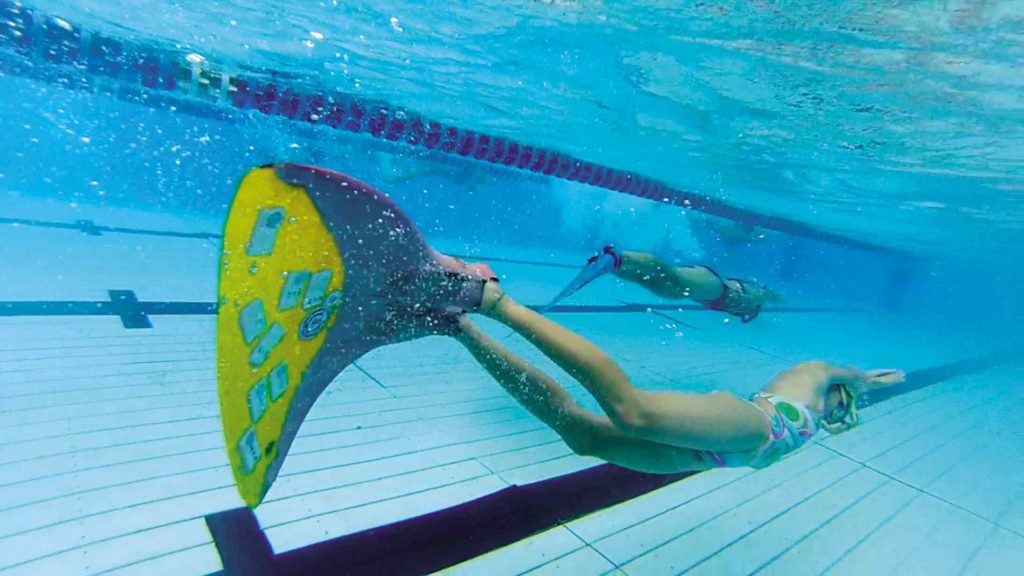Simply fin-tastic

Regular training using the monofin will make a swimmer feel like it’s an extension of the body. —PHOTOS COURTESY OF PHILIPPINE FINSWIMMING FEDERATION
Just the sight of a monofin thrilled a young Tehillah Mag-aso. Looking much like a mermaid tail, the monofin got all the kids curious. And it was no surprise that Tehillah, a swimmer most of her young life, had the fin latched to her feet in no time.
“I felt like I was Ariel in ‘The Little Mermaid,’” she says.
That “love at first sight” moment, as Tehillah calls it, came during a demonstration of finswimming. Then a relatively new sport, finswimming was introduced to different schools and pool clubs in the country, including Leyte Sports Academy where Tehillah, now 15 years old, is a scholar.
“During my childhood, I’ve always wanted to be a mermaid,” Tehillah says in Filipino. “When I saw the fins, it was love at first sight for the sport.”
But just like her beloved Disney mermaid princess who struggled walking when her fins turned into human legs, Tehillah also learned that exchanging legs for fins wasn’t easy.
Although the pool has always been like a second home, Tehillah felt like a rookie swimmer all over again. “It was hard,” recalls Tehillah. “[The monofin] was heavy. It felt tight on my feet. It took me one and a half months to adjust.”
Then there’s also learning the undulation—pretty much like mermaid moves where a swimmer treads the water in a wave-like motion. “It’s graceful and it’s the fastest way to swim,” says Philippine team coach Mary Ann Reyes. “It looks like the swimmers are on the surface, like they’re flying on the water.”
Since a different skill set is required, a good swimmer doesn’t exactly make for a good finswimmer. Mariana Reyes, a senior member of the national team, attests: “I’m not classically trained in swimming. I’m not a good classical swimmer, but I’m a good finswimmer. You just have to know the basics so that if your fin goes off, you know how to swim.”
Although the monofin will initially feel alien, regular training will make a swimmer feel like it’s an extension of the body. “The swimmer and the monofin should be one,” says coach Ann. “It’s 50 percent skills and 50 percent monofin.”
“It doesn’t necessarily have to be the most expensive monofin,” she adds. “But when you’re able to match the skill of your swimmer and the monofin, that’s when you get a good time, a good performance. You should really have that mermaid feeling.”
And for Tehillah, that feeling has translated into a medal haul. Just last May, the Baybay City athlete and the national team bagged 13 gold, six silver and seven bronze medals in the Taiwan National Age Group Finswimming Competition in Kaohsiung City. The impressive run also earned them a slot in the 16th Asian Finswimming Championship in South Korea this November.
“They’re young, dynamic and competitive,” coach Ann says of the team, composed of swimmers aged 13 to 16. “When you’re dealing with the younger ones, the absorption of skills is easier.”
For the past years, the Philippine Finswimming Federation Inc., which was recognized by the Philippine Olympic Committee only in 2009, has discovered talents from Palawan, Laguna and Leyte. And its grassroots search quickly resulted to a successful program.
In 2011, the national finswimming team debuted with a gold in the Southeast Asian Games in Palembang, Indonesia, as then 14-year-old Danielle Faith Torres ruled the 50-meter surface event. The Puerto Princesa City sensation, who now helps the team as an assistant coach, topped her event despite training for less than a year.
“It was our first time to compete in the SEA Games and we got gold right away,” coach Ann recalls. “I myself got surprised with Danielle.”
Unfortunately, finswimming got struck out in the next SEA Games editions. But that 2011 victory ended the country’s aquatics drought in the biennial meet. And with the Philippines trailing the region in competitive swimming—with Singapore even boasting an Olympic gold medalist in Joseph Schooling—finswimming may just be the next best thing as it makes a SEA Games comeback in 2019.
“I really like the sport because I never thought that with an equipment, I get even stronger in the water,” says Tehillah.
But just like any sport, she adds, it takes a lot of hard work. “You have to be physically and mentally strong,” the young talent says. “The training gets really hard. There were times when I got so tired that I wanted to quit. But I love the sport. And if you really love it, you’ll keep going.”














